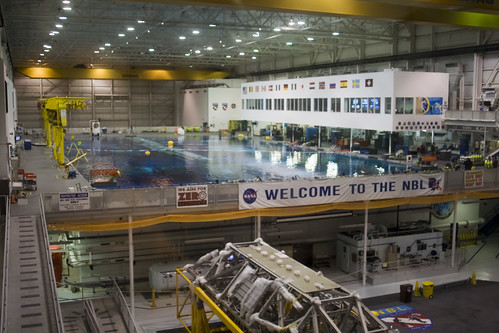 NBL Overview, originally uploaded by plemeljr
NBL Overview, originally uploaded by plemeljr
In order for astronauts to simulate and acclimate zero gravity, NASA uses the massive Neutral Buoyancy Laboratory (NBL), which is in effect a very long, deep, and largest swimming pool in the world. The NBL is not on the Johnson Space Center (JSC) main campus, but is a 10 minute drive, being housed in a converted warehouse. Here, full-sized high-fidelity Station mockups sit in 40 feet of water in order for astronauts and support staff to train for upcoming missions. Generally, two astronauts are on EVA at any one time (the buddy system), and each work together to perform a series of tasks according to the upcoming mission goals. For every astronaut who enters the water there are four additional NBL divers to assist the astronaut: one diver controls a video camera which records the training runs for both mission planners and the astronaut subjects, one tools diver who assists the astronaut, and finally two safety divers. The amount of equipment and weight of the suits make it all but impossible for the astronaut subjects to enter or exit the water without a great deal of assistance.

This training not only develops muscle memory and familiarity with Station, but also allows astronauts and support staff to develop and perfect orders of operations. Our dive escort noted that generally an overall outline and EVA mission goals have been agreed to prior to training at the NBL, but depending on the mission type and complexity, methods and procedures are worked out inside the NBL. Astronauts shoot for seven hours of training at the NBL for every one hour in EVA, though generally this fluctuates between five to eight. Generally they enter the water at 9 am and exit around 3 pm – a full day of work.

This article continues my reporting of my junket NASAtweetup at the Johnson Space Center on 17 FEB 2010. For all articles, check out the NASA tweetup page and photos.







